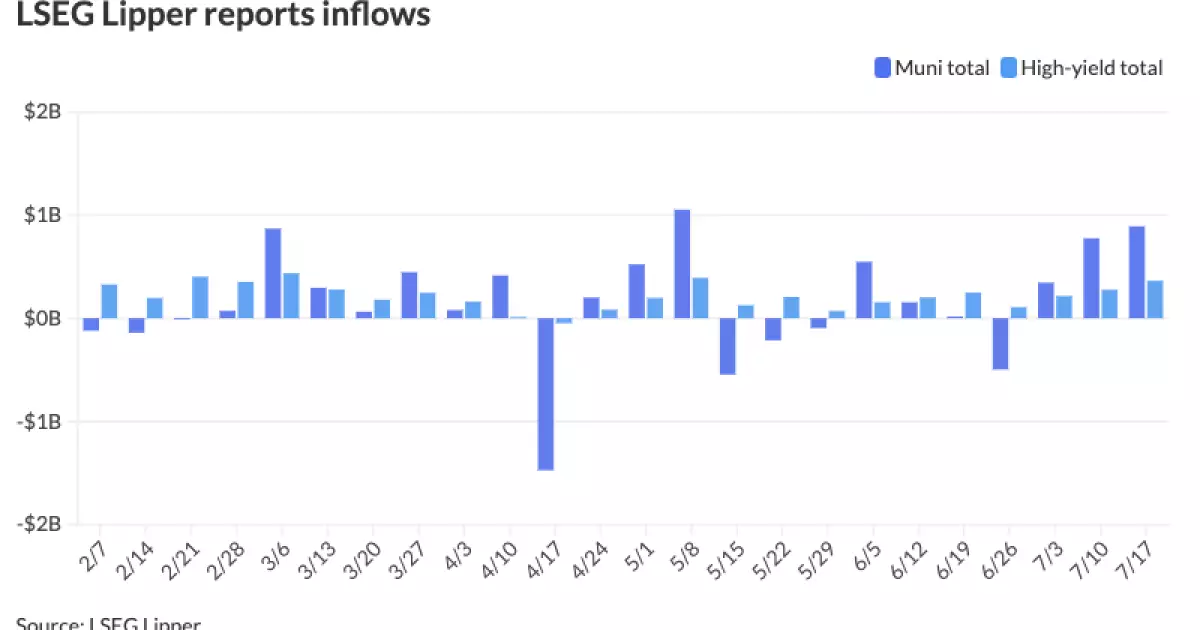Current Trends in the Municipal Bond Market: A Comprehensive Overview

The landscape of the municipal bond market has displayed noticeable shifts in recent days, with short-term municipal bonds showing slight firmness, mainly attributed to ongoing inflows into muni mutual funds. As the primary market experiences a slowdown, investors continue to exhibit confidence, pushing funds to invest $891.4 million into munis, a notable increase from the previous week’s inflow of $775.3 million. This increasing interest indicates a broader optimism surrounding municipal investments, especially in light of current fiscal pressures.
As we approach the latter half of the year, we observe a variety of trends emerging from the bond markets. U.S. Treasury yields have shown an upward trajectory with equities retracting, suggesting a typical market cycle where investors might seek the relative safety of fixed income against volatile stocks. The ratios of municipal bonds to U.S. Treasuries—as analyzed via Refinitiv Municipal Market Data—are sitting at historical averages that may offer certain investors a unique position for entering the municipal space.
Among various bond types, high-yield municipal bonds exhibit substantial resilience. Recent figures show a continuation of inflows into high-yield funds, with $364.4 million entering compared to prior weeks’ totals. This increasing allocation into high-yield munis indicates growing investor confidence, bolstered by the expectation of stable credit fundamentals in spite of potential economic slowdowns. Notably, conservative budgeting coupled with record-high reserves suggests that issuing municipalities are positioned to withstand economic fluctuations effectively.
The relative attractiveness of yields during the summer months also contributes to this sentiment. Analysts like Patrick Haskell and Sean Carney from BlackRock emphasize that the typical summer patterns, coupled with favorable relative valuations, continue to entice retail investors. Their analysis highlights the unique interplay between seasonal demand and strong performance potential, underscoring why this time may indeed be ripe for municipal bonds.
The current issuance environment reflects a healthy appetite for municipal bonds, with several large transactions on the horizon. Noteworthy is the planned pricing of $1.7 billion in Central Texas Turnpike System bonds, alongside substantial issuances from the Port of Seattle and New York City. These upcoming deals will not only satisfy institutional demand but also provide liquidity, promoting further investor engagement in the sector.
Morgan Stanley’s recent pricing for notable transactions, including green bonds for the San Francisco Public Utilities Commission and the Metropolitan Transportation Authority, highlights a transition towards sustainability in municipal finance. These efforts align with both market demands for environmentally friendly investment options and the continuing trend toward integrating ESG (Environmental, Social, and Governance) criteria within investment portfolios.
Analysts maintain a cautiously optimistic view of the municipal market, with a mixture of caution and encouragement noted among firms like GW&K Investment Management. They cite robust credit fundamentals but warn against a flattening yield curve, which may constrain potential gains. Furthermore, anticipated volatility as the November elections approach presents a dynamic that market participants must navigate carefully.
The historical context for municipal bonds during election cycles indicates possible fluctuations; however, informed investors weigh these political uncertainties against the backdrop of current financial health and yield attractiveness. Analysts suggest that as the Federal Reserve begins to adjust its monetary policies, we could witness a migration of funds from money markets back into riskier assets, including longer-duration munis.
The municipal bond market is not only resilient but also adaptive in response to the varied market pressures and opportunities presented in 2024. As investors navigate through these conditions, they must remain vigilant in monitoring both macroeconomic indicators and the evolving landscape of municipal finance. The current trajectory points toward sustained growth, driven by robust inflows, strategic issuances, and a newfound interest in sustainable investing practices.
The interplay of these elements could set the stage for a strong finish to the year, as the bonds respond to seasonal trends, investor sentiment, and potential shifts in monetary policy. Thus, the coming months promise to be essential for dedicated market participants aiming to harness the full potential of municipal bonds in their investment strategies.





